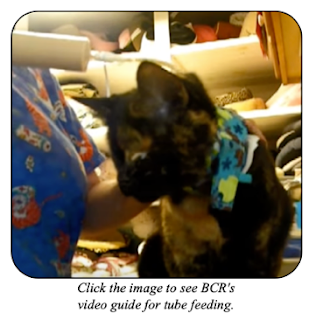Demystifying Tube Feeding Your Cat
At some time in your cat's life, they may experience an injury or illness that will make a feeding tube necessary to ensure they get the nutrition they need to recover. Everything from a broken jaw to not feeling well enough to eat to recovering from surgery can mean you'll need to learn to feed your cat with a feeding tube. Many of the BCR cats have had feeding tubes for different reasons - Wifi for his broken jaw, Sandy, Lisa and other cats had them while fighting infections or illnesses.
While the idea of doing this seems like it would hurt your cat, that isn't the case, and though it may seem like something you couldn't learn how to do, it is possible.
An added bonus for using a feeding tube is that any medications your cat needs during recovery can also be given to them that way, which means less stress for you and your cat. Cats who consistently get the nutrition and hydration they need tend to recover faster.
There are two kinds of feeding tubes generally used by veterinarians. The first is a naso-gastric tube, a narrow tube that is inserted through the nose into the stomach. The second is an esophagostomy tube, which is the more often used method and is inserted through a small hole in the neck or on a cat's side and inserted into the stomach. Using this method usually requires some sedation for the cat so he's calm and still during the procedure. An esophageal tube is slightly bigger, which makes feeding a little easier and allows fewer clogs to form.
Cats with esophageal tubes will have some extra tubing near the neck entrance that will be tucked under a dressing and protective cloth to protect it and also keep the cat from scratching in that area. The end of the tube is exposed for delivering food so it's important to make sure the cat is indoors at all times and, based on the cat's condition, has limited activity to keep the tube in place.
If your cat needs a feeding tube diet, your vet will recommend the best food based on his needs. Whatever that may be, it's important to follow the directions you're given to be sure the amount of food you need to prepare is pureed in a blender to a very liquid state so it can be delivered through the tube. How the food is given is just as important as how it is prepared. In addition to BCR's video guide on feeding tubes, icatcare.org also has helpful step-by-step instructions. Because you'll also need to make sure the tube stays unclogged your vet may train you on all the steps for successfully tube feeding your cat.
The good news is that feeding tubes are temporary and only necessary until your cat is back to health and eating on his or her own. Your vet is always there to help you with this process if you have questions or concerns. The thing to remember is that, even though tube feeding is new to you and your cat, it offers them recovery time at home in a familiar place with people they love.
CLICK HERE to read more on the types of feeding tubes used for cats and a guide for using them.



Comments
Post a Comment